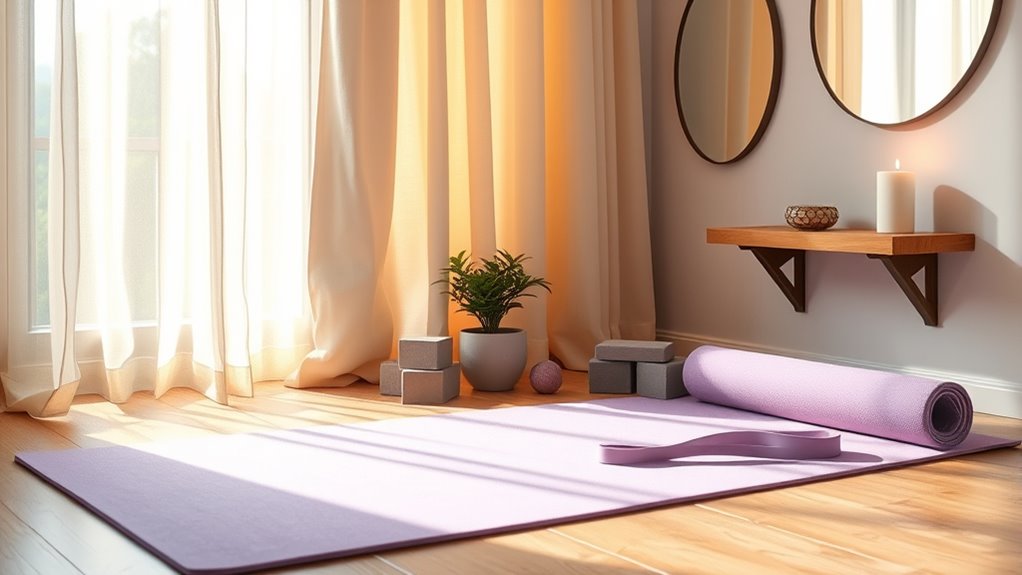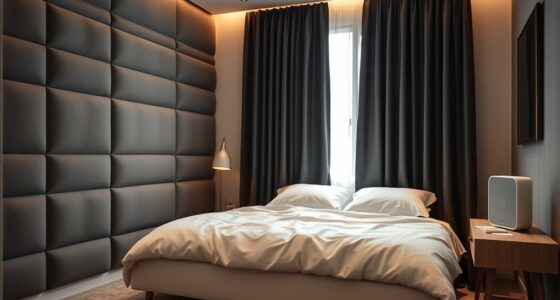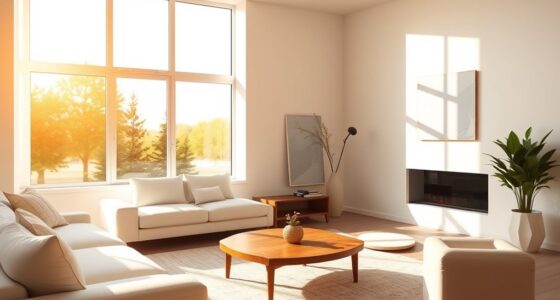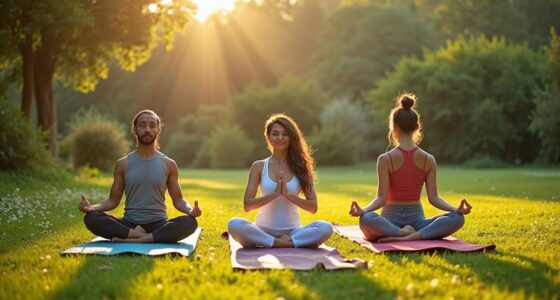To set up a home yoga space, choose a quiet area with good natural light and minimal clutter. Invest in a quality yoga mat and props like blocks and straps for support. Create a calming ambiance with soothing colors, soft textures, and gentle lighting—think candles or fairy lights. Make certain the space is safe with non-slip surfaces and good ventilation. With the right atmosphere, you can enhance your practice experience while keeping comfort in mind. There’s more to explore!
Key Takeaways
- Choose a quiet, clutter-free area with ample natural light and ventilation for a calming yoga practice environment.
- Invest in quality yoga equipment, including a mat, blocks, straps, and props for support and comfort during sessions.
- Maintain a comfortable temperature and ensure proper ventilation to enhance your practice and safety.
- Decorate with soothing colors, natural textures, and minimal decor to create a serene atmosphere for relaxation.
- Enhance ambiance with adjustable lighting, soothing music, and aromatherapy to promote a peaceful and inviting space.
Choosing the Right Location
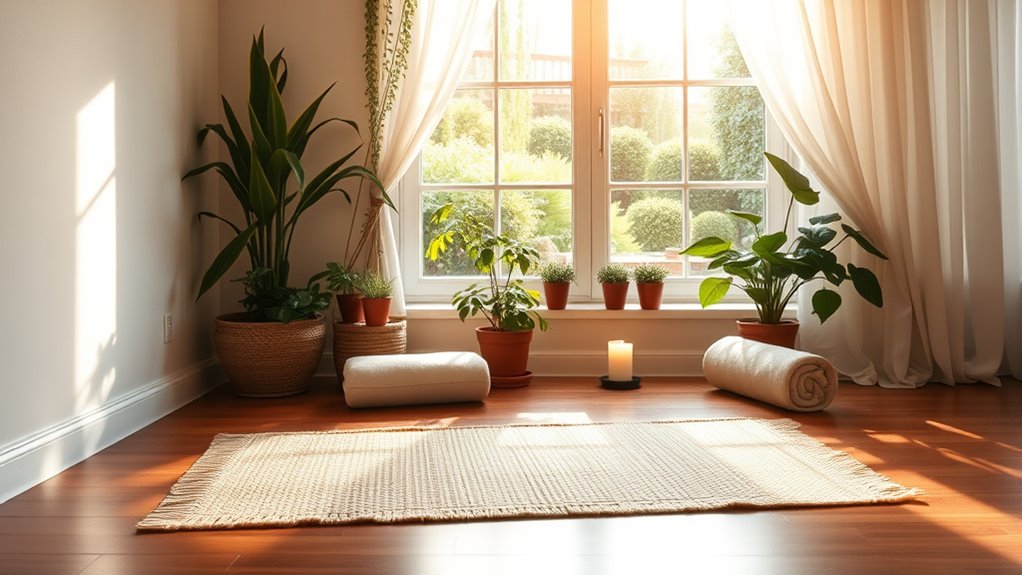
When setting up your home yoga space, the first step is choosing the right location. Look for a quiet area, free from noise and electronic distractions like TVs and phones.
Consider secluded spots such as attics, basements, or even outdoor spaces like your backyard for a serene atmosphere. Guest bedrooms or bedrooms beside your bed can also work well. A well-chosen location can significantly enhance your self-care practices, allowing for deeper relaxation and focus during your yoga sessions. Additionally, creating a peaceful environment can support healthy aging, which is essential for overall well-being. A space with good airflow can also help improve the air quality, allowing for a more refreshing practice. Incorporating elements like natural materials can further enhance the calming atmosphere of your yoga space.
Explore quiet corners like attics, basements, or your backyard to create a peaceful yoga retreat at home.
If you have a home office, clear it of work-related items to create a peaceful environment. Prioritize rooms with natural light and good ventilation to enhance your mood. Additionally, a tranquil space can facilitate better quality sleep, which contributes to improved mental health and emotional regulation.
Finally, keep the space organized and free of clutter, and try to minimize interruptions from pets and foot traffic, ensuring a tranquil space for your practice.
Essential Equipment for Your Practice

Creating a peaceful environment is just the beginning of your home yoga space; having the right equipment is equally important for a fulfilling practice.
Start with a quality yoga mat to prevent slipping and provide cushioning. Yoga blocks are essential for achieving proper alignment and modifying poses to suit your level. A yoga bolster can offer support during restorative poses, while yoga straps assist in stretching and maintaining poses beyond your natural flexibility. Incorporating essential oils for respiratory health can enhance your practice by promoting easier breathing and relaxation. Using oils like eucalyptus and tea tree can also provide antibacterial properties, adding to the overall wellness of your practice. Additionally, consider using appropriate primer for your yoga mat, as it can help maintain its longevity and performance. A balanced diet rich in nutritional information can also enhance your energy levels and support your yoga practice.
Don’t forget yoga blankets for added comfort. Invest in stretchy, moisture-wicking clothing to guarantee ease of movement and stay dry during practice. Additionally, ensure that your space is free from toxic foods for birds or other distractions that could disrupt your focus and tranquility.
With these essentials, you’ll be well-equipped to deepen your practice and enjoy every session in your dedicated space.
Design and Decor to Enhance Relaxation

To enhance relaxation in your home yoga space, focus on design elements that promote tranquility and mindfulness.
Choose a quiet area, like a spare bedroom or an alcove, to minimize distractions. Use soothing colors such as whites and earth tones to create a calming atmosphere. Incorporate natural textures like wood or bamboo for flooring, and add plants to bring life and freshness to the space. Incorporating natural elements like stones or crystals can further enhance serenity. Additionally, consider drawing inspiration from historic farmhouses that emphasize natural materials and connection to nature, as these structures often incorporate sustainable living practices that reflect harmony with the environment.
Keep your decor minimal, featuring inspirational quotes or symbols that resonate with you. Ascertain the area remains clutter-free, allowing for greater focus during your practice. Additionally, consider adding cat furniture or pads to create a harmonious environment if you have pets, helping to maintain the tranquility of your space.
Creating the Ideal Lighting and Ambiance
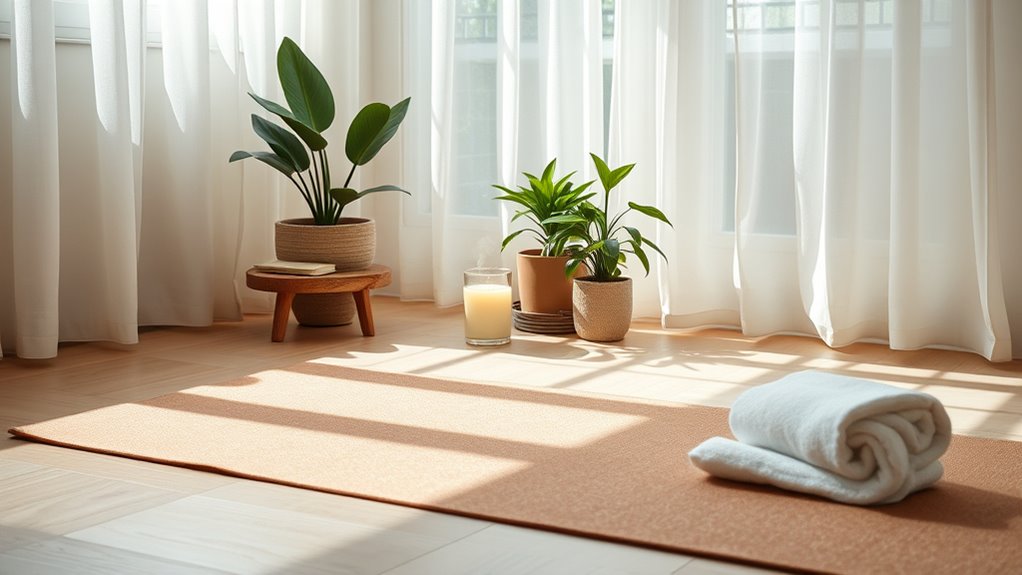
While the right lighting and ambiance can transform your yoga practice, it’s essential to contemplate how these elements affect your mood and focus.
Position your yoga mat near windows to soak up natural sunlight, which boosts serotonin levels and enhances your overall happiness. For morning sessions, large east-facing windows provide the perfect lighting. Incorporating mindful practices during your yoga sessions can further enhance your overall experience and connection to the space. Creating a dedicated area for yoga, just like setting up a backyard greenhouse, can significantly enhance your practice by providing a space that is solely focused on wellness. Additionally, integrating low light office plants into your yoga space can help purify the air, creating a refreshing environment. Engaging in luxury travel inspiration can also motivate you to elevate your home practice and create a space that feels both serene and opulent.
Consider using calming colors like blue and green to promote focus, while dimmer switches let you adjust brightness to suit your practice.
Adding soft textures and unique lighting patterns, like twinkling stars, can create a serene environment.
Enhance the ambiance with fairy lights, candles, or salt lamps for a warm glow and calming scents, making your space truly inviting and supportive for your yoga journey. Additionally, incorporating extra-large houseplants can improve air quality and create a more tranquil atmosphere.
Ensuring Safety and Functionality in Your Space
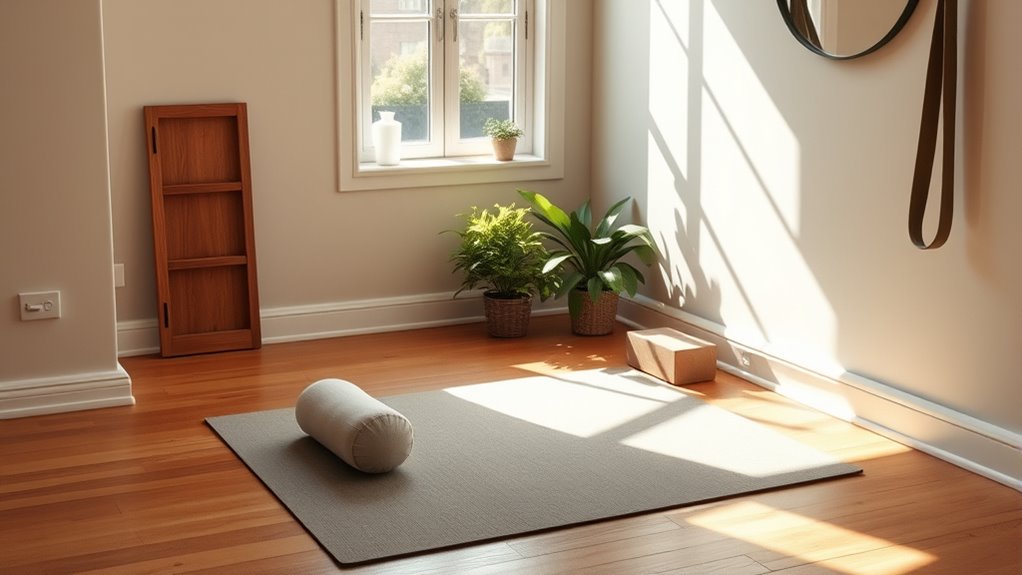
After establishing a calming atmosphere with the right lighting and ambiance, focusing on safety and functionality in your yoga space is key.
Start with non-slip flooring to prevent accidents and choose durable options that can withstand heavy use. A cushioned mat adds comfort for your joints. Confirm you have enough space for at least one mat and keep the area free from clutter for better concentration. Additionally, consider scheduling regular maintenance of your flooring to ensure it remains safe and functional over time. Installing non-combustible materials can further enhance safety by reducing fire risks. Proper maintenance of your yoga space can also extend the lifespan of your flooring and equipment, ensuring a consistently safe environment.
Proper ventilation is essential; consider using space heaters or air conditioning to maintain comfortable temperatures. Equip your space with non-slip yoga mats and props like blocks and straps for support. Incorporating energy-efficient systems can help maintain a comfortable climate while reducing operational costs.
Finally, always keep a first aid kit handy in case of injuries, confirming a safe and enjoyable practice.
Frequently Asked Questions
How Often Should I Practice Yoga in My Home Space?
You should practice yoga about three times a week if you’re just starting out. This frequency helps you learn postures and build a strong foundation.
As you progress, consider increasing your sessions based on your goals. If you aim to lose weight or reduce stress, practicing more often—up to six times a week—can be beneficial.
Just remember to listen to your body and adjust your routine as needed for balance and consistency.
Can I Use My Living Room for Yoga Practice?
Yes, you can definitely use your living room for yoga practice!
Just make sure it’s free of distractions and clutter. A cozy corner or a clear space works well, as long as you have enough room to stretch out your mat.
If your living room has slip-resistant flooring, that’s a bonus.
With some calming décor and soft lighting, it can become a peaceful retreat for your practice.
Enjoy your yoga sessions!
What Are the Best Times to Practice Yoga at Home?
The best times to practice yoga at home depend on your schedule and goals.
Early mornings are great for energizing your day and enhancing flexibility.
Mid-day sessions offer a revitalizing break, helping reduce stress and boost productivity.
If you prefer winding down, evening yoga can help you relax and prepare for sleep.
Listen to your body and choose the time that feels right for you, ensuring consistency in your practice.
How Do I Keep My Yoga Space Clutter-Free?
Your yoga space should feel like a serene oasis amidst life’s chaos.
To keep it clutter-free, start by removing items that don’t belong. Use baskets and shelves to organize props, making everything easy to access.
Choose a naturally clear area, and involve your family in maintaining this calm environment.
Regularly clean and declutter, creating a peaceful atmosphere that invites focus and serenity into your practice.
Can I Practice Yoga With Pets Around?
Absolutely, you can practice yoga with pets around!
Start with simple poses and short sessions to get them used to your practice. Use treats to reward calm behavior, and let their playful energy enhance your routine.
Just make certain your space is safe and free from hazards. Respect your pet’s boundaries, and incorporate movements that mimic their natural behaviors.
This shared practice can deepen your bond while keeping both of you engaged and relaxed. Enjoy!
Conclusion
Setting up your home yoga space is both an art and a science; it’s where tranquility meets practicality. By choosing the right location and equipping it with essential tools, you create a sanctuary that nurtures your practice. Balancing vibrant decor with calming ambiance transforms your space into a retreat. Remember, a serene environment fuels your mind, while safety guarantees you can flow freely. Embrace this duality, and you’ll find your yoga practice thriving right at home.
